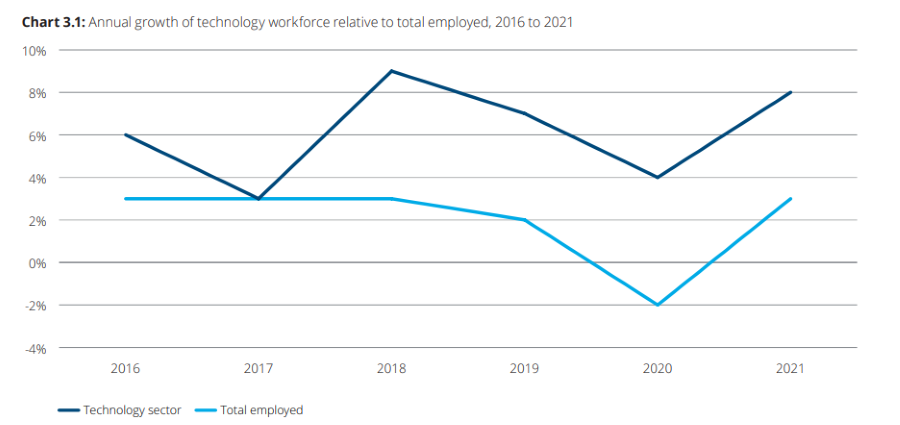Australia faces a shortage of IT skills that’s only going to deepen in the years ahead. The flip side to that is there has never been a better time to develop IT skills. Those with the right certifications and experience that can support IT capabilities in their bios and résumés will find some big new opportunities open to them.
The trick, in a market where skills are needed across the board, is making sure you train in the right areas.
Jump to:
- The Australian government (and businesses) want you
- The 5 areas of IT to train first
- Prepare for extreme flexibility
- Make it your goal to have the jobs come to you
The Australian government (and businesses) want you
According to the government, Australia will need 650,000 more tech workers by 2030. Currently, the percentage of people working in IT is expected to rise from around the 6.7% that it was in 2022 to 8.5% by 2027. At that growth rate — and given that the crisis means that the number of people with IT skills in the country needs to accelerate — to meet the government’s goal, it will need to go beyond 10% by 2030.
SEE: Australian businesses are turning to talent as a service to combat IT skills shortage.
The problem for Australia is that the percentage of people employed in technology jobs are already significantly ahead of the overall job creation rate (Figure A). There are questions about how the country can accelerate that further. However, although it’s a problem for the country, it’s also a significant opportunity for Australians to upskill and cross-skill and either step into a technology field or deepen their capabilities within it.
Figure A

The government is looking to education to support a lot of this growth. It’s making almost 500,000 placements at TAFE fee-free, which will give many Australians a rudimentary level of IT expertise and help them get their first placements in the sector.
The government will additionally support another 20,000 university students to promote advanced skills development while exploring opportunities to leverage migration to increase skills.
However, for individuals to take full advantage of the opportunity, it will be just as important to understand how to develop IT skills and careers as it will be to find courses to take.
The 5 areas of IT to train first
According to recruitment specialist, Hays, the five most in-demand areas of IT currently are:
- Cybersecurity engineers, who safeguard data, are in high demand due to the increase in cybercrime and high-profile breaches.
- Full-stack developers are proficient in both front-end and back-end development, and with digital transformation moving at pace in recent years, demand for software developers has significantly increased.
- Data analysts continue to be in demand as organizations become increasingly data-centric across all lines of business.
- Business analysts are tasked with managing the increased complexity of transformation projects across organizations and ongoing compliance and regulatory demands within certain industries.
- Project managers are in high demand as a direct reflection of the increasing volume and complexity of projects being undertaken by organizations.
It’s unlikely that the core needs behind these in-demand jobs will change over the next decade. Businesses are going to be forever invested in data and need analysts to work with it. They’re going to need developers that can build the apps that leverage the data, and they’re going to need cybersecurity specialists to protect it.
What people in each of those respective fields will be doing in their jobs is likely to change significantly, but the underlying skill sets will remain in-demand.
PREMIUM: This data scientist hiring kit highlights what’s expected for this role.
Those who want to get involved in IT should start by picking up skills in one of these five technical areas. And those already in IT should look at undertaking additional training in the two business areas to supplement their skills to ensure their career progression is in line with the IT skill sets most in demand.
IT specialists will benefit from developing business skills
For many in IT, the best approach to skills development may not involve technology at all. There’s also a great deal of demand for IT experts that understand the rest of the business and where IT falls into broader objectives.
Where once people in IT would see the CTO and then CIO as the upper echelon of the field, increasingly CIOs are being seen as ideal candidates for CEO due to their ability to execute quickly on the digital needs of the organization.
So, those technologists who do want to prepare themselves for the next decade should look at MBAs and other associated business leadership courses as those that can translate business objectives into the language of technology.
Prepare for extreme flexibility
The idea of people working in a single job or even for a single department or organization for 10 years at a time is simply not going to be reality any longer. Individual roles are going to be in constant flux, and people are going to be pushed into much more mobility between roles and companies.
World Economic Forum research highlights a future of work that is so dynamic it will appear chaotic. One in four (23%) of jobs are going to change, be that through growth (10.2%) or decline (12.3%). People are going to find themselves working for companies they never thought they would, and in roles that they hadn’t previously considered, as technology and social change pushes them in one direction or the next (Figure B).
Figure B

A critical skill to start developing now, then, is the ability to move comfortably within the chaos, and be able to move with the fastest growing jobs — especially for those currently in the declining jobs areas. Successfully doing this will have nothing to do with your technical ability, but rather your adaptability and resilience. This can be achieved with the right mindset and having a clear focus on what preparedness looks like.
Hone your soft skills
While technical expertise is important, having the ability to connect with people and form professional relationships, a willingness to learn and respect the ideas of others is just as important. People are increasingly finding that their contacts at customers or partner businesses are the ones who give them their next job, so assuming everyone you meet is important to your career development is a good first step.
Stay inquisitive and willing to learn
Reading reports, journals and news articles, watching videos, listening to podcasts, attending networking functions and seminars, and participating in online discussions are all important to being able to identify trends and find your role within them.
Become a pioneer
One way to future-proof yourself is to become a subject-matter expert in a skill set that’s in emerging demand. Think about how in-demand the first people to work with blockchain technology or artificial intelligence must be.
Identify transferable skills
Transferable skills are skills that can be applied to a variety of jobs and industries. Examples of transferable skills include communication, problem solving and teamwork. These can all be developed and taking courses on them is a good way to supplement your technical capabilities.
Earn certifications, and keep them updated
Find jobs where the employers will help you earn certifications in the technologies by major vendors. Whether that’s IBM, AWS, Microsoft, Cisco, Oracle or others, being a subject matter expert and keeping those certifications up to date is a good way of putting yourself in demand and catching the eye of recruiters.
Build a strong professional network
Your professional network can help you learn about new job opportunities and stay connected with other professionals in your field. Build a big profile on LinkedIn by connecting with people you meet, and make sure you’re seen at events. People will start to remember you.
Make it your goal to have the jobs come to you
As job mobility increases and job stability decreases, the most successful IT pros will be the ones who are found by recruiters or hear about good quality jobs via their networks before those jobs are even listed on the job search platforms. Those that get to this point will have seamless movement between jobs, with a minimal “gap” from one role to the next and will save time on sending out résumés and interviewing at multiple companies for each new role.
For well-connected IT professionals with a strong track record of delivering both technology and business outcomes, finding good work is going to be easier than ever, and the opportunities to really build a career have never been stronger. It all comes down to how well you can strategically plan out your career and make sure you have the skills and job history to be most in demand.

